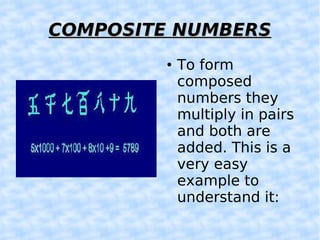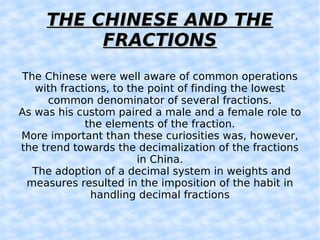Maths: China
- 1. CHINESE NUMBERING SYSTEM Juan Miguel Sabastro L¨®pez Daniel Villalta Rodr¨ªguez Jos¨¦ David Su¨¢rez Rodr¨ªguez V¨ªctor Daniel Gil Becerra
- 2. SIMPLE NUMBERS The classical writing form in China started to be used in 1500 B.C. It is a decimal system and it used the different potencies of ten. It is a hybrid system.
- 3. COMPOSITE NUMBERS To form composed numbers they multiply in pairs and both are added. This is a very easy example to understand it:
- 4. MULTIPLICATION AND DIVISION The Chinese used the abaco for multiplication and division numbers and they decorated this with painting about women, flowers, dragons and more things.
- 5. THE CHINESE AND THE FRACTIONS The Chinese were well aware of common operations with fractions, to the point of finding the lowest common denominator of several fractions. As was his custom paired a male and a female role to the elements of the fraction. More important than these curiosities was, however, the trend towards the decimalization of the fractions in China. The adoption of a decimal system in weights and measures resulted in the imposition of the habit in handling decimal fractions




